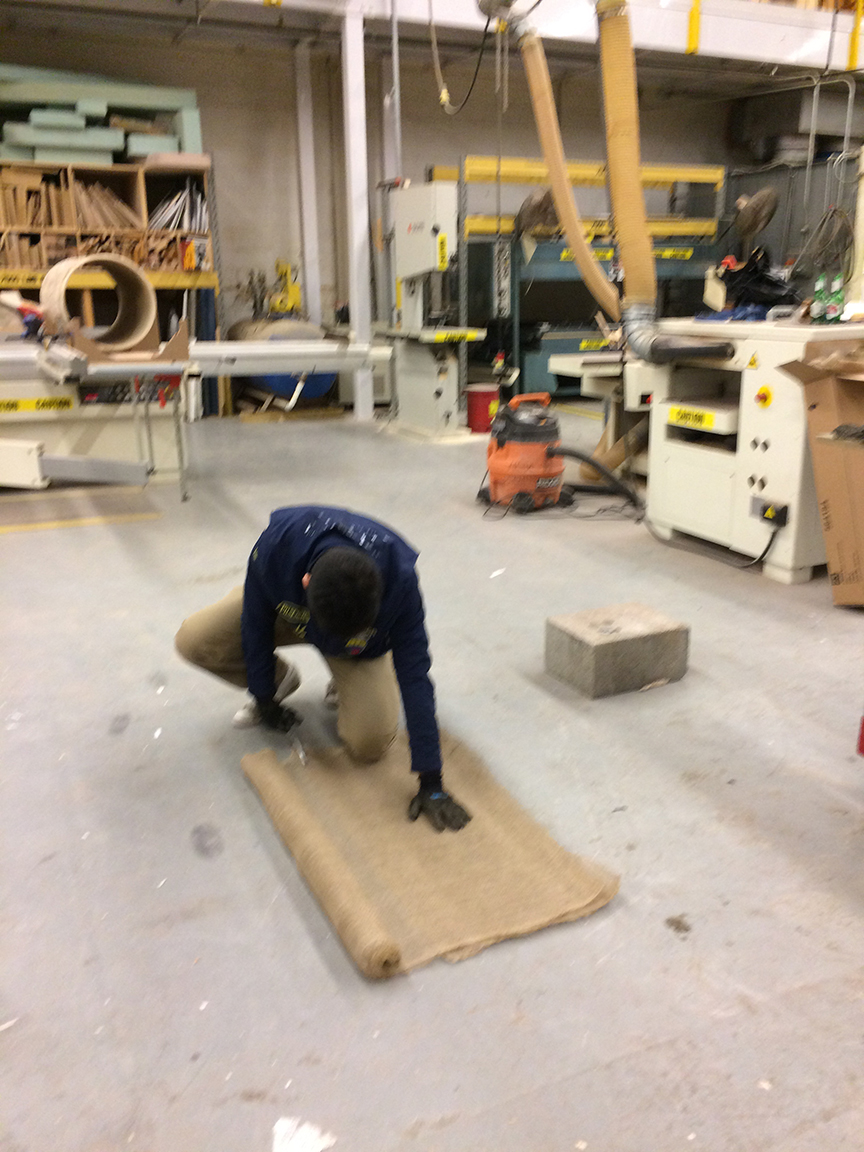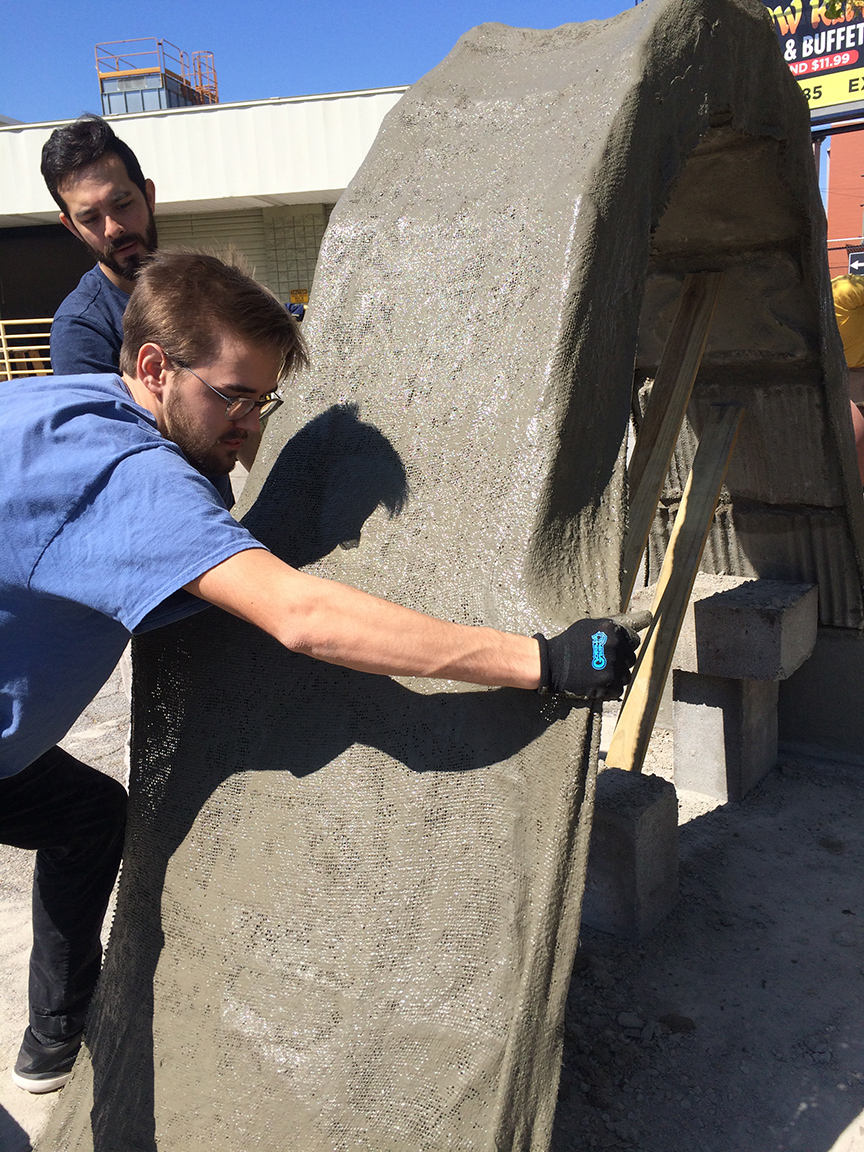Of Fungus And Vaults
Material Exploration
Spring, 2018
Mycelium + Food + Water = Mushroom
The full paper can be found here: Of Fungus And Vaults: Mycelium and Funicular Shell Structures
ACT ONE
“The ugliest thing I have ever seen”
— Anonymous Critic
Research into building with biomaterials such as mycelium bio-composites is still in the early stages of exploration. Mycelium has the potential to have a big impact on bio-construction. Mycelium has, to date, been used in a very conventional manor; forming blocks that aggregate into a unitized system and treated as substitutes for techniques such as brick construction. While this is a great leap forward in bio-based construction, our research has demonstrated that mycelium-based composites have great potential to be used in monolithic construction practices resembling cast in place concrete. Growing monolithic structures from mycelium can reduce time and labor while giving more control of overall form allowing for optimized structural performance. While more testing is required, monolithic mycelium has the potential to redefine bio-based construction.
On this page, when referring to mycelium as a building material, a bio-composite consisting of wood chips, mushroom spores, mushroom tissue,water, and flour is being referenced. The mycelium uses the flour as a rapidly available food source and grows from the spores and tissue fragments spreading between the wood chips searching for more flour. Once the flour has been consumed the mycelium begins to bind to and break down the wood chips. Drying the mixture forces the mycelium into a hardened dormant state while baking the dried composite will kill all the hyphae comprising the mycelial networks and prevent any future growth.
Our initial experiment is the first known successful use of mycelium in a monolithic structure. The goal was to create a self-supporting structure out of mycelium given 4 cubic feet of material. Our only knowledge of the material at the time was that it is a very low strength material so extreme care was placed into the analysis of the form before growth. Utilizing Rhino Vault as our form finding strategy we created a triangular vault that would withstand its own live load.
Formwork extrapolated from the Rhino Vault geometry and produced from laser cut cardboard arranged in an intersecting waffle pattern.
Activated mycelium is fed more flour before being placed into its final position within each cell of the cardboard formwork. To hold the mycelium blend in place and prevent drying, the structure is wrapped in plastic sheeting and duct tape. In an attempt to increase bonding between the cardboard and mycelium (this is not needed we later discovered) the cardboard formwork was misted with water causing it to collapse almost immediately; a carefully planned secondary system of wood scraps was implemented to hold the form in place.
After initial growth, the plastic is removed to allow the mycelium to dry. Thick volumes such as the base of each leg of the vault maintains water for long periods of time allowing growth of mushrooms; the fruits pictured above popped up after a heavy rain storm a few weeks after unwrapping.
This vault was never load tested to failure but in the most recent test, two 170+ pound people can stand on it with very minimal deflection. This inspired the team to launch an investigation into the possibilities of using mycelium composites to construct larger structures.
ACT TWO
Growing mycelium is easy; growing mold, even more so.
After observing mold growth on some samples of mycelium in the lab we began considering ways we could seal the mycelium to provide safe air quality in an inhabitable mycelium structure. For budgeting purposes, we substituted scraps of 1lb density EPS foam for mycelium. This provides a compressive strength comparable to the mycelium we had been working with.
Using graphic statics and Kangaroo Physics particle springs we created a doubly curved arch in Rhinoceros that we then discretized and reproduced using a CNC hot wire cutter.
We applied three layers of burlap that were first soaked in Portland Cement on five of the six sides to achieve a thin barrier between the would-be mycelium and the occupied space.
After allowing the cement to cure for two days we assembled the arch using mortar to join the blocks. The final step was to use the same cementitious fabric to seal and post tension the exterior of the arch. Using a superplasticizer, we were able to achieve a mix that resulted in a more consistent coverage of the burlap. Three layers of continuous burlap were first wetted with water to aid in absorption of the cement, submerged in cement, and stretched across the length of the arch.
ACT THREE
Mini-Monolith
Noticing an RFP for a music festival that we could qualify for, we designed a full scale pavilion. A two day design charrette generated a pavilion resembling a British Gothic fan vault. The design is based off a mushroom column that is then split into four sections and rearranged such that the tension located in the top of the column bares against the adjacent sections and becomes a compression-only structure.
The original proposal was intended to provide shade in an otherwise sunny park for a small group or provide a unique setting for a small performance.
The Mini-Monolith is the prototype for our final project. Ultimately mold contamination led to a failed final product, however we were able to learn valuable lessons for controlling surfaces using both plastic sheeting and ridged walls.
ACT FOUR
Extra-Medio Monolito Micelio
Ultimately we were not awarded the project from the original submission though we decided to use the rest of our research money to forge ahead with a half scale version. It is an 8’x8’x8’ cube based off the exact geometry of the Mini-Monolith. This project is the largest monolithically formed mycelium project to date utilizing 2,300 pounds of raw material.
We began by generating the internal form defining structure based on the geometry associated with the British Gothic fan vaults of the middle ages. The wooden structure referred to as “lost-work” provides the regulating geometry for forming and ultimately becomes a food source for the mycelium.
Working with such a large volume of material, it was necessary to obtain a cement mixer to efficiently mix the medium with flour as a rapidly available food source. To avoid the heat and CO2 buildup experienced on our prototype, we transitioned to a woven polypropylene geotextile in place of the plastic sheeting we had used for prior experiments. To define our internal volume, we fixed the geotextile to the exterior walls using acrylic-lined white shower board as our guide and leaving three inches of cover between the lost-work and geotextile.
After growing for four days we uncovered the thinner bases of the vault to allow those regions to begin to harden to support the weight of the upper portion of the vault. The following day we uncovered the top portion. It is interesting the effect one day of direct exposure to oxygen has on the production of the chitin coating mycelium. A distinct difference in color and texture can be observed.
During the Year-End Show Extra-Medio lived up to its initial performance criteria: a unique setting for a performance. A four-man a cappella group performed a brief concert; they praised the acoustics.





















































